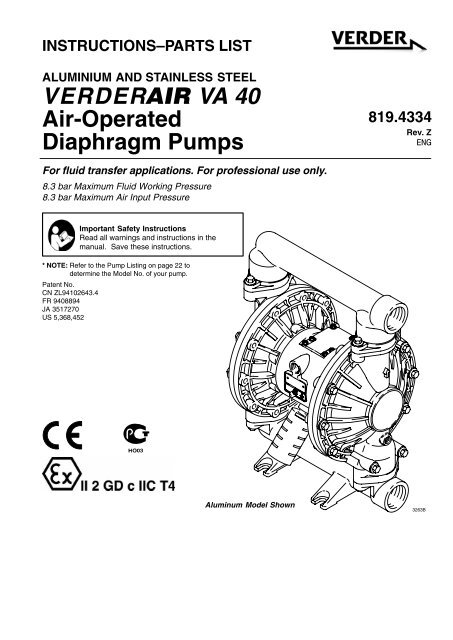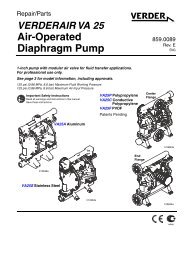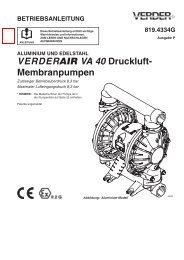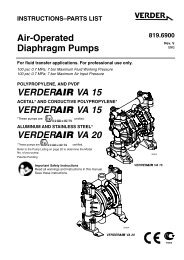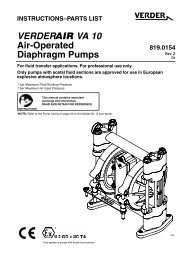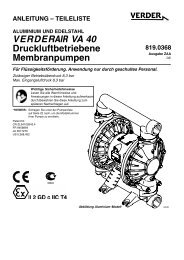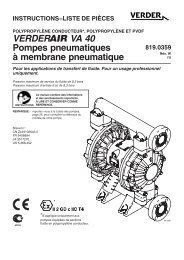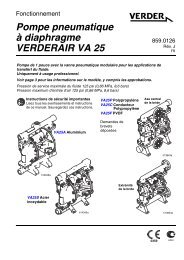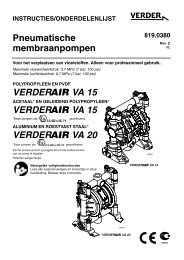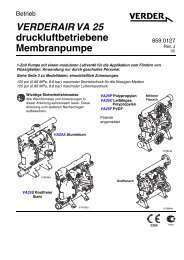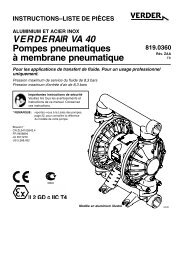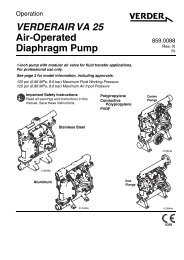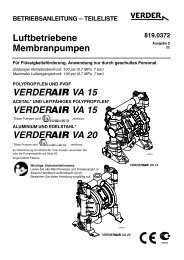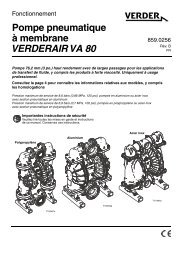V E R D E R VA 40 Air-Operated Diaphragm Pumps
Warning - Double Diaphragm Pump
Warning - Double Diaphragm Pump
- No tags were found...
Create successful ePaper yourself
Turn your PDF publications into a flip-book with our unique Google optimized e-Paper software.
INSTRUCTIONS–PARTS LIST<br />
ALUMINIUM AND STAINLESS STEEL<br />
V E R D E R <strong>VA</strong> <strong>40</strong><br />
<strong>Air</strong>-<strong>Operated</strong><br />
<strong>Diaphragm</strong> <strong>Pumps</strong><br />
819.4334<br />
Rev. Z<br />
<br />
For fluid transfer applications. For professional use only.<br />
8.3 bar Maximum Fluid Working Pressure<br />
8.3 bar Maximum <strong>Air</strong> Input Pressure<br />
Important Safety Instructions<br />
Read all warnings and instructions in the<br />
manual. Save these instructions.<br />
* NOTE: Refer to the Pump Listing on page 22 to<br />
determine the Model No. of your pump.<br />
Patent No.<br />
CN ZL94102643.4<br />
FR 9<strong>40</strong>8894<br />
JA 3517270<br />
US 5,368,452<br />
Aluminum Model Shown<br />
3263B
Table of Contents<br />
Safety Warnings . . . . . . . . . . . . . . . . . . . . . . . . . . . . . . . . . . . . . 2<br />
Symbols . . . . . . . . . . . . . . . . . . . . . . . . . . . . . . . . . . . . . . . . . . . 2<br />
Installation . . . . . . . . . . . . . . . . . . . . . . . . . . . . . . . . . . . . . . . . . . 4<br />
Operation . . . . . . . . . . . . . . . . . . . . . . . . . . . . . . . . . . . . . . . . . . 9<br />
Maintenance . . . . . . . . . . . . . . . . . . . . . . . . . . . . . . . . . . . . . . . 10<br />
Troubleshooting . . . . . . . . . . . . . . . . . . . . . . . . . . . . . . . . . . . . 12<br />
Service<br />
Repairing the <strong>Air</strong> Valve . . . . . . . . . . . . . . . . . . . . . . . . . . 14<br />
Ball Check Valve Repair . . . . . . . . . . . . . . . . . . . . . . . . . 16<br />
<strong>Diaphragm</strong> Repair . . . . . . . . . . . . . . . . . . . . . . . . . . . . . . 17<br />
Bearing and <strong>Air</strong> Gasket Removal . . . . . . . . . . . . . . . . . 20<br />
Pump Listing . . . . . . . . . . . . . . . . . . . . . . . . . . . . . . . . . . . . . . . 22<br />
Repair Kit Listing . . . . . . . . . . . . . . . . . . . . . . . . . . . . . . . . . . . 23<br />
Parts . . . . . . . . . . . . . . . . . . . . . . . . . . . . . . . . . . . . . . . . . . . . . 24<br />
Torque Sequence . . . . . . . . . . . . . . . . . . . . . . . . . . . . . . . . . . . 28<br />
Dimensions . . . . . . . . . . . . . . . . . . . . . . . . . . . . . . . . . . . . . . . . 29<br />
Technical Data and Performance Chart . . . . . . . . . . . . . . . . 30<br />
Customer Services/Guarantee . . . . . . . . . . . . . . . . . . . . . . . . 32<br />
Symbols<br />
Warning Symbol<br />
Warning<br />
This symbol alerts you to the possibility of serious injury or<br />
death if you do not follow the instructions.<br />
Caution Symbol<br />
Caution<br />
This symbol alerts you to the possibility of damage to or<br />
destruction of equipment if you do not follow the instructions.<br />
EQUIPMENT MISUSE HAZARD<br />
Warning<br />
INSTRUCTIONS<br />
Equipment misuse can cause the equipment to rupture or malfunction and result in serious injury.<br />
<br />
This equipment is for professional use only.<br />
<br />
<br />
<br />
<br />
<br />
<br />
<br />
<br />
<br />
<br />
<br />
Read all instruction manuals, tags, and labels before operating the equipment.<br />
Use the equipment only for its intended purpose. If you are not sure, call VERDER After Sales Service.<br />
Do not alter or modify this equipment.<br />
Check equipment daily. Repair or replace worn or damaged parts immediately.<br />
Do not exceed the maximum working pressure of the lowest rated component in your system. This equipment<br />
has an 8.4 bar maximum working pressure at 8.4 bar maximum incoming air pressure.<br />
Use fluids and solvents which are compatible with the equipment wetted parts. Refer to the Technical Data<br />
section of all equipment manuals. Read the fluid and solvent manufacturer’s warnings.<br />
Do not use 1,1,1-trichloroethane, methylene chloride, other halogenated hydrocarbon solvents or fluids<br />
containing such solvents in pressurized aluminum equipment. Such use could result in a chemical reaction,<br />
with the possibility of explosion.<br />
Do not use hoses to pull equipment.<br />
Route hoses away from traffic areas, sharp edges, moving parts, and hot surfaces. Do not expose VERDER<br />
hoses to temperatures above 82C or below -<strong>40</strong>C.<br />
Do not lift pressurized equipment.<br />
Comply with all applicable local, state, and national fire, electrical, and safety regulations.<br />
2 819.4334
TOXIC FLUID HAZARD<br />
Warning<br />
Hazardous fluid or toxic fumes can cause serious injury or death if splashed in the eyes or on the skin, inhaled,<br />
or swallowed.<br />
<br />
<br />
<br />
<br />
Know the specific hazards of the fluid you are using.<br />
Store hazardous fluid in an approved container. Dispose of hazardous fluid according to all local, state, and<br />
national guidelines.<br />
Always wear protective eyewear, gloves, clothing, and respirator as recommended by the fluid and solvent<br />
manufacturer.<br />
Pipe and dispose of the exhaust air safely, away from people, animals, and food handling areas. If the<br />
diaphragm fails, the fluid is exhausted along with the air. See <strong>Air</strong> Exhaust Ventilation on page 8.<br />
FIRE AND EXPLOSION HAZARD<br />
Improper grounding, poor ventilation, open flames or sparks can cause a hazardous condition and result in a fire<br />
or explosion and serious injury.<br />
Ground the equipment. Refer to Grounding on page 4.<br />
<br />
<br />
<br />
<br />
<br />
<br />
<br />
<br />
<br />
If there is any static sparking or you feel an electric shock while using this equipment, stop pumping<br />
immediately. Do not use the equipment until you identify and correct the problem.<br />
Provide fresh air ventilation to avoid the buildup of flammable fumes from solvents or the fluid being sprayed.<br />
Pipe and dispose of the exhaust air safely, away from all sources of ignition. If the diaphragm fails, the fluid is<br />
exhausted along with the air. See <strong>Air</strong> Exhaust Ventilation on page 8.<br />
Keep the work area free of debris, including solvent, rags, and gasoline.<br />
Electrically disconnect all equipment in the work area.<br />
Extinguish all open flames or pilot lights in the work area.<br />
Do not smoke in the work area.<br />
Do not turn on or off any light switch in the work area while operating or if fumes are present.<br />
Do not operate a gasoline engine in the work area.<br />
819.4334 3
Installation<br />
General Information<br />
1. The Typical Installation shown in Fig. 2 is only a guide<br />
for selecting and installing system components. Contact<br />
your VERDER Customer Service for assistance in planning<br />
a system to suit your needs.<br />
2. Always use Genuine VERDER Parts and Accessories.<br />
Refer to Product Data Sheet 819.4335.<br />
3. Reference numbers and letters in parentheses refer to<br />
the callouts in the figures and the parts lists on<br />
pages 24–25.<br />
4. Lift the pump by grasping the outlet manifold (1)<br />
securely. See Fig. 3 on page 7.<br />
Warning<br />
TOXIC FLUID HAZARD<br />
Hazardous fluid or toxic fumes can<br />
cause serious injury or death if<br />
splashed in the eyes or on the skin,<br />
inhaled, or swallowed.<br />
Ground all of this equipment:<br />
<br />
Pump: Connect a ground wire and clamp as shown in<br />
Fig. 1. Loosen the grounding screw (W). Insert one end of<br />
a 1.5 mm minimum ground wire (Y) behind the grounding<br />
screw and tighten the screw securely. Connect the clamp<br />
end of the ground wire to a true earth ground. Order<br />
Part No. 819.0157 Ground Wire and Clamp.<br />
Y<br />
1. Read TOXIC FLUID HAZARD on page 3.<br />
2. Use fluids and solvents which are compatible<br />
with the equipment wetted parts. Refer to the<br />
Technical Data section of all equipment manuals.<br />
Read the fluid and solvent manufacturer’s<br />
warnings.<br />
Tightening Screws Before First Use<br />
Before using the pump for the first time, check and retorque<br />
all external fasteners. See Torque Sequence, page 28.<br />
After the first day of operation, retorque the fasteners.<br />
Although pump use varies, a general guideline is to retorque<br />
fasteners every two months.<br />
Fig. 1<br />
W<br />
02646B<br />
Grounding<br />
Warning<br />
FIRE AND EXPLOSION HAZARD<br />
This pump must be grounded. Before<br />
operating the pump, ground the system as<br />
explained below. Also, read the section FIRE<br />
AND EXPLOSION HAZARD, on page 3.<br />
To reduce the risk of static sparking, ground the pump and all<br />
other equipment used or located in the pumping area. Check<br />
your local electrical code for detailed grounding instructions<br />
for your area and type of equipment.<br />
<br />
<br />
<br />
<br />
<strong>Air</strong> and fluid hoses: Use only grounded hoses with a<br />
maximum of 150 m combined hose length to ensure<br />
grounding continuity.<br />
<strong>Air</strong> compressor: Follow the manufacturer’s recommendations.<br />
All solvent pails used when flushing, according to local<br />
code. Use only metal pails, which are conductive. Do not<br />
place the pail on a non-conductive surface, such as paper<br />
or cardboard, which interrupts the grounding continuity.<br />
Fluid supply container: Follow the local code.<br />
4 819.4334
Installation<br />
Mountings<br />
Caution<br />
The pump exhaust air may contain contaminants. Ventilate<br />
to a remote area if the contaminants could affect your fluid<br />
supply. See <strong>Air</strong> Exhaust Ventilation on page 8.<br />
1. Be sure the mounting surface can support the weight of<br />
the pump, hoses, and accessories, as well as the stress<br />
caused during operation.<br />
2. For all mountings, be sure the pump is bolted directly to<br />
the mounting surface.<br />
3. For ease of operation and service, mount the pump so<br />
the air valve cover (2), air inlet, and fluid inlet and outlet<br />
ports are easily accessible.<br />
4. Rubber Foot Mounting Kit 819.4333 is available to<br />
reduce noise and vibration during operation.<br />
<strong>Air</strong> Line<br />
Warning<br />
A bleed-type master air valve (B) is required in your system<br />
to relieve air trapped between this valve and the pump.<br />
Trapped air can cause the pump to cycle unexpectedly,<br />
which could result in serious injury, including splashing in<br />
the eyes or on the skin, injury from moving parts, or<br />
contamination from hazardous fluids. See Fig. 2.<br />
1. Install the air line accessories as shown in Fig. 2. Mount<br />
these accessories on the wall or on a bracket. Be sure<br />
the air line supplying the accessories is grounded.<br />
a. Install an air regulator (C) and gauge to control the<br />
fluid pressure. The fluid outlet pressure will be the<br />
same as the setting of the air regulator.<br />
b. Locate one bleed-type master air valve (B) close to<br />
the pump and use it to relieve trapped air. See the<br />
Warning above. Locate the other master air<br />
valve (E) upstream from all air line accessories and<br />
use it to isolate them during cleaning and repair.<br />
c. The air line filter (F) removes harmful dirt and moisture<br />
from the compressed air supply.<br />
2. Install a grounded, flexible air hose (A) between the<br />
accessories and the 1/2 npt(f) pump air inlet (N). See<br />
Fig. 3. Use a minimum 13 mm ID air hose. Screw an air<br />
line quick disconnect coupler (D) onto the end of the air<br />
hose (A), and screw the mating fitting into the pump air<br />
inlet snugly. Do not connect the coupler (D) to the fitting<br />
until you are ready to operate the pump.<br />
Fluid Suction Line<br />
1. Use grounded fluid hoses (G). The pump fluid inlet (R)<br />
is 1–1/2 in. bspt. On pumps 810.0195, 810.0196,<br />
810.0197, and 810.0198, the pump fluid inlet is 1–1/2 in.<br />
npt. Screw the fluid fitting into the pump inlet securely.<br />
2. If the fluid inlet pressure to the pump is more than 25% of<br />
the outlet working pressure, the ball check valves will not<br />
close fast enough, resulting in inefficient pump operation.<br />
3. At inlet fluid pressures greater than 1.05 bar, diaphragm<br />
life will be shortened.<br />
4. See the Technical Data on page 30 for maximum suction<br />
lift (wet and dry).<br />
Fluid Outlet Line<br />
Warning<br />
A fluid drain valve (J) is required to relieve pressure in the<br />
hose if it is plugged. The drain valve reduces the risk of serious<br />
injury, including splashing in the eyes or on the skin, or<br />
contamination from hazardous fluids when relieving pressure.<br />
Install the valve close to the pump fluid outlet. See<br />
Fig. 2.<br />
1. Use grounded fluid hoses (L). The pump fluid outlet<br />
(S) is 1–1/2 in. bspt. On pumps 810.0195, 810.0196,<br />
810.0197, and 810.0198, the pump fluid outlet is 1–1/2<br />
in. npt. Screw the fluid fitting into the pump outlet securely.<br />
2. Install a fluid drain valve (J) near the fluid outlet. See the<br />
Warning above.<br />
3. Install a shutoff valve (K) in the fluid outlet line.<br />
819.4334 5
Installation<br />
FLOOR MOUNT TYPICAL<br />
INSTALLATION<br />
KEY<br />
A <strong>Air</strong> Supply Hose<br />
B Bleed-Type Master <strong>Air</strong> Valve<br />
(required for pump)<br />
C <strong>Air</strong> Regulator<br />
D <strong>Air</strong> Line Quick Disconnect<br />
E Master <strong>Air</strong> Valve (for accessories)<br />
F <strong>Air</strong> Line Filter<br />
G Fluid Suction Hose<br />
H Fluid Supply<br />
J Fluid Drain Valve (required)<br />
K Fluid Shutoff Valve<br />
L Fluid Hose<br />
R* 1–1/2 in. bspt Fluid Inlet Port<br />
S* 1–1/2 in. bspt Fluid Outlet Port<br />
Y Ground Wire (required; see page 4<br />
for installation instructions)<br />
Y<br />
D<br />
A<br />
B<br />
S<br />
K<br />
C<br />
F<br />
L<br />
E<br />
J<br />
H<br />
R<br />
G<br />
Fig. 2<br />
03265B<br />
* On pumps 810.0195, 810.0196, 810.0197, and 810.0198, inlet and outlet ports are 1–1/2 in. npt threads.<br />
6 819.4334
Installation<br />
Changing the Orientation of the Fluid Inlet and<br />
Outlet Ports<br />
The pump is shipped with the fluid inlet (R) and outlet (S)<br />
ports facing the same direction. See Fig. 3. To change the<br />
orientation of the inlet and/or outlet port:<br />
1. Remove the screws (106) holding the inlet (102) and/or<br />
outlet (103) manifold to the covers (101).<br />
2. Reverse the manifold and reattach. Install the screws<br />
and torque to 14–17 Nm. See Torque Sequence, page<br />
28.<br />
KEY<br />
N 1/2 npt(f) <strong>Air</strong> Inlet Port<br />
P Muffler; <strong>Air</strong> Exhaust Port<br />
is 3/4 npt(f)<br />
R* 1–1/2 in. bspt Fluid<br />
Inlet Port<br />
S* 1–1/2 in. bspt Fluid<br />
Outlet Port<br />
1 Torque to 14–17 Nm. See Torque Sequence,<br />
page 28.<br />
2 Torque to 22–25 Nm. See Torque Sequence,<br />
page 28.<br />
101 Covers<br />
102 Fluid Inlet Manifold<br />
103 Fluid Outlet Manifold<br />
106 Manifold and Cover<br />
Screws<br />
112 Bottom Cover Screws<br />
Aluminum Model Shown<br />
Fluid Pressure Relief Valve<br />
Caution<br />
Some systems may require installation of a pressure relief<br />
valve at the pump outlet to prevent overpressurization and<br />
rupture of the pump or hose. See Fig. 4.<br />
Thermal expansion of fluid in the outlet line can cause overpressurization.<br />
This can occur when using long fluid lines<br />
exposed to sunlight or ambient heat, or when pumping from<br />
a cool to a warm area (for example, from an underground<br />
tank).<br />
Overpressurization can also occur if the pump is being used<br />
to feed fluid to a piston pump, and the intake valve of the<br />
piston pump does not close, causing fluid to back up in the<br />
outlet line.<br />
KEY<br />
R* 1–1/2 in. bspt Fluid Inlet Port<br />
S* 1–1/2 in. bspt Fluid Outlet Port<br />
V Pressure Relief Valve (Order Part No. 819.0159)<br />
103<br />
106<br />
1<br />
1<br />
Install valve between fluid inlet and outlet ports.<br />
2 Connect fluid inlet line here.<br />
S<br />
3<br />
Connect fluid outlet line here.<br />
N<br />
S<br />
3<br />
2<br />
106<br />
V<br />
1<br />
112<br />
101<br />
2<br />
2<br />
P<br />
R<br />
Fig. 3<br />
102<br />
03263B<br />
Fig. 4<br />
R<br />
03461B<br />
* On pumps 810.0195, 810.0196, 810.0197, and 810.0198, inlet and outlet ports are 1–1/2 in. npt threads.<br />
819.4334 7
Installation<br />
<strong>Air</strong> Exhaust Ventilation<br />
Warning<br />
FIRE AND EXPLOSION HAZARD<br />
Be sure to read and follow the warnings and<br />
precautions regarding TOXIC FLUID<br />
HAZARD, and FIRE OR EXPLOSION<br />
HAZARD on page 3, before operating this<br />
pump.<br />
The air exhaust port is 3/4 npt(f). Do not restrict the air exhaust<br />
port. Excessive exhaust restriction can cause erratic<br />
pump operation.<br />
If the muffler (P) is installed directly to the air exhaust port,<br />
apply PTFE thread tape or anti–seize thread lubricant to the<br />
muffler threads before assembly.<br />
To provide a remote exhaust:<br />
1. Remove the muffler (P) from the pump air exhaust port.<br />
Be sure the system is properly ventilated for your type of<br />
installation. You must vent the exhaust to a safe place, away<br />
from people, animals, food handling areas, and all sources<br />
of ignition when pumping flammable or hazardous fluids.<br />
<strong>Diaphragm</strong> failure will cause the fluid being pumped to exhaust<br />
with the air. Place an appropriate container at the end<br />
of the air exhaust line to catch the fluid. See Fig. 5.<br />
2. Install a grounded air exhaust hose (T) and connect the<br />
muffler (P) to the other end of the hose. The minimum<br />
size for the air exhaust hose is 19 mm ID. If a hose longer<br />
than 4.57 m is required, use a larger diameter hose.<br />
Avoid sharp bends or kinks in the hose. See Fig. 5.<br />
3. Place a container (U) at the end of the air exhaust line to<br />
catch fluid in case a diaphragm ruptures.<br />
VENTING EXHAUST AIR<br />
E<br />
F<br />
C<br />
B<br />
A<br />
KEY<br />
A <strong>Air</strong> Supply Line<br />
B Bleed-Type Master <strong>Air</strong> Valve<br />
(required for pump)<br />
C <strong>Air</strong> Regulator<br />
D <strong>Air</strong> Line Quick Disconnect<br />
E Master <strong>Air</strong> Valve (for accessories)<br />
F <strong>Air</strong> Line Filter<br />
P Muffler<br />
T Grounded <strong>Air</strong> Exhaust Hose<br />
U Container for Remote <strong>Air</strong> Exhaust<br />
D<br />
T<br />
U<br />
P<br />
Fig. 5<br />
03267A<br />
8 819.4334
Operation<br />
Pressure Relief Procedure<br />
PRESSURIZED EQUIPMENT HAZARD<br />
The equipment stays pressurized until pressure is manually<br />
relieved. To reduce the risk of serious injury from pressurized<br />
fluid, accidental spray from the gun or splashing fluid,<br />
follow this procedure whenever you:<br />
<br />
<br />
<br />
<br />
Are instructed to relieve pressure,<br />
Stop pumping,<br />
Warning<br />
Check, clean or service any system equipment,<br />
Install or clean fluid nozzles.<br />
1. Shut off the air to the pump.<br />
2. Open the dispensing valve, if used.<br />
3. Open the fluid drain valve to relieve all fluid pressure,<br />
having a container ready to catch the drainage.<br />
Flush the Pump Before First Use<br />
The pump was tested with lightweight oil, which is left in the<br />
fluid passages to protect parts. To avoid contaminating your<br />
fluid with oil, flush the pump with a compatible solvent before<br />
using the equipment. Follow the steps under Starting and<br />
Adjusting the Pump.<br />
5. Close the fluid drain valve (J). See Fig. 2.<br />
6. Close the pump air regulator (C). Open all bleed-type<br />
master air valves (B, E).<br />
7. If the fluid hose has a dispensing device, hold it open<br />
while continuing with the following step.<br />
8. Slowly open the air regulator (C) until the pump starts to<br />
cycle. Allow the pump to cycle slowly until all air is<br />
pushed out of the lines and the pump is primed.<br />
If you are flushing, run the pump long enough to<br />
thoroughly clean the pump and hoses. Close the air<br />
regulator. Remove the suction tube from the solvent and<br />
place it in the fluid to be pumped.<br />
Pump Shutdown<br />
Warning<br />
To reduce the risk of serious injury whenever you are<br />
instructed to relieve pressure, always follow the Pressure<br />
Relief Procedure at left.<br />
At the end of the work shift, relieve the pressure.<br />
Starting and Adjusting the Pump<br />
Warning<br />
TOXIC FLUID HAZARD<br />
To reduce the risk of serious injury, splashing<br />
in the eyes or on the skin, and toxic fluid<br />
spills, never move or lift a pump under<br />
pressure. If dropped, the fluid section may<br />
rupture. Always follow the Pressure Relief Procedure<br />
above before lifting the pump.<br />
1. Be sure the pump is properly grounded. Refer to<br />
Grounding on page 4.<br />
2. Check all fittings to be sure they are tight. Be sure to use<br />
a compatible liquid thread sealant on all male threads.<br />
Tighten the fluid inlet and outlet fittings securely.<br />
3. Place the suction tube (if used) in the fluid to be pumped.<br />
NOTE: If the fluid inlet pressure to the pump is more than<br />
25% of the outlet working pressure, the ball check<br />
valves will not close fast enough, resulting in inefficient<br />
pump operation.<br />
4. Place the end of the fluid hose (L) into an appropriate<br />
container.<br />
819.4334 9
Maintenance<br />
Lubrication<br />
The air valve is designed to operate unlubricated, however if<br />
lubrication is desired, every 500 hours of operation (or<br />
monthly) remove the hose from the pump air inlet and add<br />
two drops of machine oil to the air inlet.<br />
Caution<br />
Do not over-lubricate the pump. Oil is exhausted through the<br />
muffler, which could contaminate your fluid supply or other<br />
equipment. Excessive lubrication can also cause the pump<br />
to malfunction.<br />
Flushing and Storage<br />
Warning<br />
Tightening Threaded Connections<br />
Before each use, check all hoses for wear or damage, and<br />
replace as necessary. Check to be sure all threaded connections<br />
are tight and leak-free. Check fasteners. Tighten or<br />
retorque as necessary. Although pump use varies, a general<br />
guideline is to retorque fasteners every two months. See<br />
Torque Sequence, page 28.<br />
Preventive Maintenance Schedule<br />
Establish a preventive maintenance schedule, based on the<br />
pump’s service history. This is especially important for<br />
prevention of spills or leakage due to diaphragm failure.<br />
To reduce the risk of serious injury whenever you are<br />
instructed to relieve pressure, always follow the Pressure<br />
Relief Procedure on page 9.<br />
Flush the pump often enough to prevent the fluid you are<br />
pumping from drying or freezing in the pump and damaging it.<br />
Use a compatible solvent.<br />
Always flush the pump and relieve the pressure before storing<br />
it for any length of time.<br />
10 819.4334
Notes<br />
819.4334 11
Troubleshooting<br />
Warning<br />
To reduce the risk of serious injury whenever you are<br />
instructed to relieve pressure, always follow the Pressure<br />
Relief Procedure on page 9.<br />
1. Relieve the pressure before checking or servicing the<br />
equipment.<br />
2. Check all possible problems and causes before<br />
disassembling the pump.<br />
PROBLEM CAUSE SOLUTION<br />
Pump cycles at stall or fails to hold<br />
pressure at stall.<br />
Pump will not cycle, or cycles once and<br />
stops.<br />
Worn check valve balls (301),<br />
seats (201) or o-rings (202).<br />
<strong>Air</strong> valve is stuck or dirty.<br />
Check valve ball (301) severely worn<br />
and wedged in seat (201) or<br />
manifold (102 or 103).<br />
Check valve ball (301) is wedged into<br />
seat (201), due to overpressurization.<br />
Dispensing valve clogged.<br />
Replace. See page 16.<br />
Disassemble and clean air valve. See<br />
pages 14–15. Use filtered air.<br />
Replace ball and seat. See page 16.<br />
Install Pressure Relief Valve<br />
(see page 7).<br />
Relieve pressure and clear valve.<br />
Pump operates erratically. Clogged suction line. Inspect; clear.<br />
Sticky or leaking balls (301). Clean or replace. See page 16.<br />
<strong>Diaphragm</strong> ruptured. Replace. See pages 17–19.<br />
Restricted exhaust.<br />
Remove restriction.<br />
<strong>Air</strong> bubbles in fluid. Suction line is loose. Tighten.<br />
<strong>Diaphragm</strong> ruptured. Replace. See pages 17–19.<br />
Loose inlet manifold (102), damaged<br />
seal between manifold and seat (201),<br />
damaged o-rings (202).<br />
Tighten manifold bolts (106) or replace<br />
seats (201) or o-rings (202). See<br />
page 16.<br />
Loose diaphragm shaft bolt (107). Tighten or replace. See pages 17–19.<br />
Damaged o-ring (108). Replace. See pages 17–19.<br />
12 819.4334
Troubleshooting<br />
PROBLEM CAUSE SOLUTION<br />
Fluid in exhaust air. <strong>Diaphragm</strong> ruptured. Replace. See pages 17–19.<br />
Loose diaphragm shaft bolt (107). Tighten or replace. See pages 17–19.<br />
Damaged o-ring (108). Replace. See pages 17–19.<br />
Pump exhausts excessive air at stall.<br />
Worn air valve block (7), o-ring (6),<br />
plate (8), pilot block (18), u-cups<br />
(10), or pilot pin o-rings (17).<br />
Repair or replace. See pages 14–15.<br />
Worn shaft seals (<strong>40</strong>2). Replace. See pages 17–19.<br />
Pump leaks air externally.<br />
<strong>Air</strong> valve cover (2) or air valve cover<br />
screws (3) are loose.<br />
<strong>Air</strong> valve gasket (4) or air cover<br />
gasket (22) is damaged.<br />
Tighten screws. See page 15.<br />
Inspect; replace.<br />
See pages 14–15, 20–21.<br />
<strong>Air</strong> cover screws (25) are loose. Tighten screws. See pages 20–21.<br />
Pump leaks fluid externally from ball<br />
check valves.<br />
Loose manifolds (102, 103), damaged<br />
seal between manifold and seat (201),<br />
damaged o-rings (202).<br />
Tighten manifold bolts (106) or replace<br />
seats (201) or o-rings (202). See<br />
page 16.<br />
819.4334 13
Service<br />
Repairing the <strong>Air</strong> Valve<br />
Tools Required<br />
Torque wrench<br />
3 2<br />
2<br />
4†<br />
<br />
<br />
<br />
<br />
Torx (T20) screwdriver or 7 mm socket wrench<br />
Needle-nose pliers<br />
O-ring pick<br />
Lithium base grease<br />
NOTE: <strong>Air</strong> Valve Repair Kits 819.4274 (aluminum center<br />
housing models) and 819.0249 (sst center housing<br />
models) are available. Refer to page 23. Parts included<br />
in the kit are marked with a symbol, for example<br />
(4). Use all the parts in the kit for the best results.<br />
Disassembly<br />
Warning<br />
To reduce the risk of serious injury whenever you are<br />
instructed to relieve pressure, always follow the Pressure<br />
Relief Procedure on page 9.<br />
2<br />
Fig. 6<br />
Torque to 50–60 in–lb (5.6–6.8 Nm)<br />
03268B<br />
1. Relieve the pressure.<br />
2. With a Torx (T20) screwdriver or 7 mm socket wrench,<br />
remove the six screws (3), air valve cover (2), and gasket<br />
(4). See Fig. 6.<br />
1 See Detail at right.<br />
2 Grease.<br />
3 Grease lower face.<br />
2<br />
5<br />
6<br />
3. Move the valve carriage (5) to the center position and<br />
pull it out of the cavity. Remove the valve block (7) and<br />
o-ring (6) from the carriage. Using a needle-nose pliers,<br />
pull the pilot block (18) straight up and out of the cavity.<br />
See Fig. 7.<br />
3<br />
7<br />
4. Pull the two actuator pistons (11) out of the bearings<br />
(12). Remove the u-cup packings (10) from the<br />
pistons. Pull the pilot pins (16) out of the bearings (15).<br />
Remove the o-rings (17) from the pilot pins. See Fig.<br />
8.<br />
18 3 5 1<br />
11<br />
5. Inspect the valve plate (8) in place. If damaged, use a<br />
Torx (T20) screwdriver or 7 mm socket wrench to remove<br />
the three screws (3). Remove the valve plate (8)<br />
and, on aluminum center housing models, remove the<br />
seal (9). See Fig. 9.<br />
6. Inspect the bearings (12, 15) in place. See Fig. 8. The<br />
bearings are tapered and, if damaged, must be removed<br />
from the outside. This requires disassembly of the fluid<br />
section. See page 20.<br />
7. Clean all parts and inspect for wear or damage. Replace<br />
as needed. Reassemble as explained on page 15.<br />
14 819.4334<br />
Fig. 7<br />
03269B
Service<br />
1<br />
Insert narrow end first.<br />
Reassembly<br />
2<br />
3<br />
Grease.<br />
Install with lips facing<br />
narrow end of piston (11).<br />
4 Insert wide end first.<br />
1. If you removed the bearings (12, 15), install new ones as<br />
explained on page 20. Reassemble the fluid section.<br />
10<br />
2<br />
3<br />
2. On aluminum center housing models, install the valve<br />
plate seal (9†) into the groove at the bottom of the valve<br />
cavity. The rounded side of the seal must face down<br />
into the groove. See Fig. 9.<br />
11<br />
4<br />
12<br />
3. Install the valve plate (8) in the cavity. On aluminum<br />
center housing models, the plate is reversible, so either<br />
side can face up. Install the three screws (3), using a<br />
Torx (T20) screwdriver or 7 mm socket wrench. Tighten<br />
until the screws bottom out on the housing. See Fig. 9.<br />
4. Install an o-ring (17) on each pilot pin (16). Grease the<br />
pins and o-rings. Insert the pins into the bearings (15),<br />
narrow end first. See Fig. 8.<br />
Fig. 8<br />
2<br />
17 15 16<br />
1<br />
03270B<br />
5. Install a u-cup packing (10) on each actuator piston<br />
(11), so the lips of the packings face the narrow end<br />
of the pistons. See Fig. 8.<br />
1<br />
2<br />
Rounded side must face down (aluminum<br />
center housing models only).<br />
Tighten screws until they bottom<br />
out on the housing.<br />
3<br />
8<br />
2<br />
6. Lubricate the u-cup packings (10) and actuator pistons<br />
(11). Insert the actuator pistons in the bearings (12),<br />
wide end first. Leave the narrow end of the pistons<br />
exposed. See Fig. 8.<br />
9†<br />
1<br />
7. Grease the lower face of the pilot block (18) and install<br />
so its tabs snap into the grooves on the ends of the pilot<br />
pins (16). See Fig. 7.<br />
8. Grease the o-ring (6) and install it in the valve block<br />
(7). Push the block onto the valve carriage (5). Grease<br />
the lower face of the valve block. See Fig. 7.<br />
9. Install the valve carriage (5) so its tabs slip into the<br />
grooves on the narrow end of the actuator pistons (11).<br />
See Fig. 7.<br />
Fig. 9<br />
03271<br />
10. Align the valve gasket (4) and cover (2) with the six<br />
holes in the center housing (1). Secure with six<br />
screws (3), using a Torx (T20) screwdriver or 7 mm socket<br />
wrench. Torque to 50–60 in–lb (5.6–6.8 Nm). See<br />
Fig. 6.<br />
819.4334 15
Service<br />
Ball Check Valve Repair<br />
Tools Required<br />
1<br />
2<br />
Torque to 14–17 Nm. See Torque Sequence, page 28.<br />
Arrow (A) must point toward outlet manifold (103).<br />
<br />
<br />
Torque wrench<br />
13 mm socket wrench<br />
3 Not used on some models.<br />
4 Beveled seating surface must face ball (301).<br />
<br />
O-ring pick<br />
Disassembly<br />
1<br />
106<br />
NOTE: A Fluid Section Repair Kit is available. Refer to<br />
page 23 to order the correct kit for your pump. Parts<br />
included in the kit are marked with an asterisk, for<br />
example (201*). Use all the parts in the kit for the<br />
best results.<br />
NOTE: To ensure proper seating of the balls (301), always<br />
replace the seats (201) when replacing the balls.<br />
Also, on some models, replace the o-rings (202).<br />
Warning<br />
To reduce the risk of serious injury whenever you are<br />
instructed to relieve pressure, always follow the Pressure<br />
Relief Procedure on page 9.<br />
103<br />
301*<br />
201*<br />
202*<br />
101<br />
A 2<br />
4<br />
3<br />
1. Relieve the pressure. Disconnect all hoses.<br />
2. Remove the pump from its mounting.<br />
3. Using a 13 mm socket wrench, remove the four<br />
bolts (106) holding the outlet manifold (103) to the fluid<br />
covers (101). See Fig. 10.<br />
4. Remove the o-rings (202, not used on some models),<br />
seats (201), and balls (301) from the manifold.<br />
5. Turn the pump over and remove the inlet manifold (102).<br />
Remove the o-rings (202, not used on some models),<br />
seats (201), and balls (301) from the fluid covers (101).<br />
Reassembly<br />
1. Clean all parts and inspect for wear or damage. Replace<br />
parts as needed.<br />
301*<br />
201*<br />
202*<br />
102<br />
4<br />
3<br />
2. Reassemble in the reverse order, following all notes in<br />
Fig. 10. Be sure the ball checks are assembled exactly<br />
as shown. The arrows (A) on the fluid covers (101) must<br />
point toward the outlet manifold (103). Fig. 10<br />
106<br />
1<br />
03272B<br />
16 819.4334
Service<br />
<strong>Diaphragm</strong> Repair<br />
Tools Required<br />
<br />
<br />
<br />
Torque wrench<br />
13 mm open–end wrench<br />
15 mm socket wrench (aluminum models) or 1 in. socket<br />
wrench (stainless steel models)<br />
Disassembly<br />
NOTE: A Fluid Section Repair Kit is available. Refer to<br />
page 23 to order the correct kit for your pump. Parts<br />
included in the kit are marked with an asterisk, for<br />
example (<strong>40</strong>1*). Use all the parts in the kit for the<br />
best results.<br />
Warning<br />
To reduce the risk of serious injury whenever you are<br />
instructed to relieve pressure, always follow the Pressure<br />
Relief Procedure on page 9.<br />
1. Relieve the pressure.<br />
<br />
<br />
<br />
19 mm socket wrench<br />
O-ring pick<br />
Lithium-base grease<br />
2. Remove the manifolds and disassemble the ball check<br />
valves as explained on page 16.<br />
3. Using a 13 mm socket wrench, remove the screws<br />
(106 and 112) holding the fluid covers (101) to the air<br />
covers (23). Pull the fluid covers (101) off the pump. See<br />
Fig. 11.<br />
1<br />
2<br />
Torque to 22–25 Nm. See Torque Sequence, page 28.<br />
Arrow (A) must point toward air valve (B).<br />
B<br />
23<br />
101<br />
A 2<br />
106<br />
1<br />
112 1<br />
Fig. 11<br />
03273B<br />
819.4334 17
Service<br />
4. Loosen but do not remove the diaphragm shaft<br />
bolts (107), using a 15 mm socket wrench (1 in. on stainless<br />
steel models) on both bolts.<br />
5. Unscrew one bolt from the diaphragm shaft (24) and<br />
remove the o-ring (108), fluid side diaphragm plate (105),<br />
PTFE diaphragm (<strong>40</strong>3, used on PTFE models only), diaphragm<br />
(<strong>40</strong>1), and air side diaphragm plate (104). See<br />
Fig. 12.<br />
6. Pull the other diaphragm assembly and the diaphragm<br />
shaft (24) out of the center housing (1). Hold the shaft<br />
flats with a 19 mm open–end wrench, and remove the<br />
bolt (107) from the shaft. Disassemble the remaining<br />
diaphragm assembly.<br />
7. Inspect the diaphragm shaft (24) for wear or scratches. If<br />
it is damaged, inspect the bearings (19) in place. If the<br />
bearings are damaged, refer to page 20.<br />
8. Reach into the center housing (1) with an o-ring pick and<br />
hook the u-cup packings (<strong>40</strong>2), then pull them out of the<br />
housing. This can be done with the bearings (19) in<br />
place.<br />
9. Clean all parts and inspect for wear or damage. Replace<br />
parts as needed.<br />
Reassembly<br />
1. Install the shaft u-cup packings (<strong>40</strong>2*) so the lips face<br />
out of the housing (1). Lubricate the packings. See<br />
Fig. 12.<br />
2. Install the diaphragm assembly on one end of the<br />
shaft (24) as follows:<br />
a. Install the o-ring (108*) on the shaft bolt (107).<br />
b. Install the fluid side diaphragm plate (105) on the<br />
bolt so the rounded side faces in, toward the diaphragm<br />
(<strong>40</strong>1).<br />
c. On PTFE models only, install the PTFE diaphragm<br />
(<strong>40</strong>3*). Make certain the side marked AIR<br />
SIDE faces the center housing (1).<br />
d. Install the diaphragm (<strong>40</strong>1*) on the bolt. Make<br />
certain the side marked AIR SIDE faces the center<br />
housing (1).<br />
e. Install the air side diaphragm plate (104) so the<br />
recessed side faces the diaphragm (<strong>40</strong>1).<br />
f. Apply medium-strength Loctite or equivalent to the<br />
bolt (107) threads. Screw the bolt (107) into the<br />
shaft (24) handtight.<br />
3. Grease the length and ends of the diaphragm shaft (24),<br />
and slide it through the housing (1).<br />
4. Assemble the other diaphragm assembly to the shaft as<br />
explained in step 2.<br />
5. Hold one shaft bolt (107) with a wrench and torque the<br />
other bolt to 27–34 Nm at 100 rpm maximum.<br />
6. Align the fluid covers (101) and the center housing (1) so<br />
the arrows (A) on the covers face the same direction as<br />
the air valve (B). Secure the covers with the screws (106<br />
and 112), handtight. Install the longer screws (112) in the<br />
bottom holes of the covers. See Fig. 11. Using a 13 mm<br />
socket wrench, torque the screws oppositely and evenly<br />
to 22–25 Nm. See Torque Sequence, page 28.<br />
7. Reassemble the ball check valves and manifolds as<br />
explained on page 16.<br />
18 819.4334
Service<br />
105<br />
2<br />
19 <strong>40</strong>2*<br />
1<br />
107<br />
5<br />
<strong>40</strong>3*<br />
1<br />
24 104 <strong>40</strong>1*<br />
3<br />
6<br />
1<br />
4<br />
7<br />
3<br />
Cutaway View, with <strong>Diaphragm</strong>s in Place<br />
03274<br />
03275<br />
Cutaway View, with <strong>Diaphragm</strong>s Removed<br />
24<br />
4<br />
104<br />
7<br />
<strong>40</strong>1*<br />
3<br />
<strong>40</strong>3*<br />
3<br />
6<br />
105<br />
2<br />
1<br />
108*<br />
24<br />
4<br />
107<br />
5<br />
1<br />
2<br />
3<br />
4<br />
5<br />
6<br />
Lips face out of housing (1).<br />
Rounded side faces diaphragm (<strong>40</strong>1).<br />
<strong>Air</strong> Side must face center housing (1).<br />
Grease.<br />
Apply medium-strength Loctite or equivalent.<br />
Torque to 27–34 Nm at 100 rpm maximum.<br />
Used on pumps with PTFE diaphragms only.<br />
7 Recessed side faces diaphragm (<strong>40</strong>1).<br />
Fig. 12<br />
03276B<br />
819.4334 19
Service<br />
Bearing and <strong>Air</strong> Gasket Removal<br />
Tools Required<br />
<br />
<br />
<br />
<br />
<br />
Torque wrench<br />
10 mm socket wrench<br />
Bearing puller<br />
O-ring pick<br />
Press, or block and mallet<br />
Disassembly<br />
NOTE: Do not remove undamaged bearings.<br />
Warning<br />
To reduce the risk of serious injury whenever you are<br />
instructed to relieve pressure, always follow the Pressure<br />
Relief Procedure on page 9.<br />
1. Relieve the pressure.<br />
2. Remove the manifolds and disassemble the ball check<br />
valves as explained on page 16.<br />
2. The bearings (12, 15, and 19) are tapered and can only<br />
be installed one way. Insert the bearings into the center<br />
housing (1), tapered end first. Using a press or a block<br />
and rubber mallet, press-fit the bearing so it is flush with<br />
the surface of the center housing.<br />
3. Reassemble the air valve as explained on page 15.<br />
4. Align the new air cover gasket (22) so the pilot pin (16)<br />
protruding from the center housing (1) fits through the<br />
proper hole (H) in the gasket.<br />
5. Align the air cover (23) so the pilot pin (16) fits in the<br />
middle hole (M) of the three small holes near the center<br />
of the cover. Install the screws (25), handtight. See<br />
Fig. 13. Using a 10 mm socket wrench, torque the<br />
screws oppositely and evenly to 15–17 Nm.<br />
6. Install the diaphragm assemblies and fluid covers as<br />
explained on page 17.<br />
7. Reassemble the ball check valves and manifolds as explained<br />
on page 16.<br />
3. Remove the fluid covers and diaphragm assemblies as<br />
explained on page 17.<br />
NOTE: If you are removing only the diaphragm shaft bearing<br />
(19), skip step 4.<br />
4. Disassemble the air valve as explained on page 14.<br />
5. Using a 10 mm socket wrench, remove the screws (25)<br />
holding the air covers (23) to the center housing (1). See<br />
Fig. 13.<br />
6. Remove the air cover gaskets (22). Always replace the<br />
gaskets with new ones.<br />
7. Use a bearing puller to remove the diaphragm shaft<br />
bearings (19), air valve bearings (12) or pilot pin bearings<br />
(15). Do not remove undamaged bearings.<br />
8. If you removed the diaphragm shaft bearings (19), reach<br />
into the center housing (1) with an o-ring pick and hook<br />
the u-cup packings (<strong>40</strong>2), then pull them out of the housing.<br />
Inspect the packings. See Fig. 12.<br />
Reassembly<br />
1. If removed, install the shaft u-cup packings (<strong>40</strong>2*) so the<br />
lips face out of the housing (1).<br />
20 819.4334
Service<br />
1<br />
2<br />
Insert bearings tapered end first.<br />
Press-fit bearings flush with surface of center housing (1).<br />
12<br />
1<br />
2<br />
3<br />
Torque to 15–17 Nm.<br />
1<br />
16<br />
15 1 2<br />
Detail of <strong>Air</strong> Valve Bearings<br />
19<br />
2<br />
1<br />
H<br />
22<br />
M<br />
23<br />
03277<br />
25<br />
3<br />
Fig. 13<br />
03278B<br />
819.4334 21
Pump Listing<br />
VERDER <strong>VA</strong> <strong>40</strong> Aluminium and Stainless Steel pumps, Series B<br />
Your Model No. is marked on the pump’s serial plate. The listing of existing VERDERAIR <strong>VA</strong> <strong>40</strong> pumps is below:<br />
<strong>Air</strong> Fluid<br />
Part No. Section Section Seats Balls <strong>Diaphragm</strong>s<br />
810.1632 ALU<br />
ÁÁÁÁ<br />
ALU 316<br />
ÁÁÁ<br />
TEF TEF<br />
ÁÁÁÁ<br />
810.1633 ALU<br />
ÁÁÁÁ<br />
ALU<br />
ÁÁÁÁ<br />
316 ÁÁÁ<br />
TEF HYT<br />
810.16<strong>40</strong> ALU<br />
ÁÁÁÁ<br />
ALU<br />
ÁÁÁÁ<br />
316 ÁÁÁ<br />
TEF<br />
810.1685 ALU ÁÁÁÁ<br />
ALU ÁÁÁÁ<br />
HYT<br />
ÁÁÁ ACE HYT<br />
810.1722 ALU ÁÁÁÁ<br />
ALU ÁÁÁÁ<br />
SAN<br />
ÁÁÁ SAN SAN<br />
810.1752 ALU ÁÁÁÁ<br />
ALU ÁÁÁÁ<br />
POL<br />
ÁÁÁ TEF TEF<br />
810.1770 ALU ÁÁÁÁ<br />
ALU ÁÁÁÁ<br />
POL<br />
ÁÁÁ SAN SAN<br />
810.6986 ALU ALU GEO GEO GEO<br />
ÁÁÁÁ ÁÁÁÁÁÁ<br />
810.6987 ALU SST 316 GEO GEO<br />
810.1800 ALU ÁÁÁÁ<br />
SST 316 ÁÁÁ TEF TEF<br />
ÁÁÁÁ<br />
810.1818 ALU<br />
ÁÁÁÁ<br />
SST<br />
ÁÁÁÁ<br />
316 ÁÁÁ<br />
SAN SAN<br />
810.1823 ALU<br />
ÁÁÁÁ<br />
SST<br />
ÁÁÁÁ<br />
316 ÁÁÁ<br />
VIT VIT<br />
810.1853 ALU SST<br />
HYT<br />
ACE HYT<br />
ÁÁÁÁ<br />
ÁÁÁÁÁÁ<br />
810.1857 ALU<br />
SST HYT 4<strong>40</strong><br />
ÁÁÁÁ<br />
HYT<br />
ÁÁÁÁÁÁ<br />
810.1890 ALU SST SAN SAN SAN<br />
810.1920 ALU<br />
ÁÁÁÁ<br />
SST<br />
ÁÁÁÁ<br />
POL<br />
ÁÁÁ<br />
TEF TEF<br />
810.7026 ALU<br />
ÁÁÁÁ<br />
SST<br />
ÁÁÁÁ<br />
SST<br />
ÁÁÁ<br />
TEF TEF<br />
810.0092 ALU ALU SST BUN BUN<br />
ÁÁÁÁÁ<br />
ÁÁÁÁÁ<br />
ÁÁÁÁÁ<br />
ÁÁÁÁÁ<br />
ÁÁÁÁÁ<br />
ÁÁÁÁÁ<br />
ÁÁÁÁÁ<br />
ÁÁÁÁÁ<br />
ÁÁÁÁÁ<br />
ÁÁÁÁÁ<br />
ÁÁÁÁÁ<br />
ÁÁÁÁÁ<br />
ÁÁÁÁÁ<br />
ÁÁÁÁÁ<br />
ÁÁÁÁÁ<br />
ÁÁÁÁÁ<br />
ÁÁÁÁÁ<br />
ÁÁÁÁÁ<br />
4<strong>40</strong><br />
ÁÁÁÁÁ<br />
ÁÁÁÁÁ<br />
ÁÁÁÁÁ<br />
ÁÁÁÁÁ<br />
ÁÁÁÁÁ<br />
ÁÁÁÁÁ<br />
ÁÁÁÁÁ<br />
ÁÁÁÁÁ<br />
ÁÁÁÁÁ<br />
ÁÁÁÁÁ<br />
ÁÁÁÁÁ<br />
ÁÁÁÁÁ<br />
ÁÁÁÁÁ<br />
ÁÁÁÁÁÁÁ<br />
ÁÁÁÁ<br />
ÁÁÁÁ<br />
810.0093 ALU ALU BUN BUN BUN<br />
810.0094 ALU ALU VIT VIT VIT<br />
810.0095 ALU SST SST BUN BUN<br />
810.0096 ALU SST VIT VIT VIT<br />
810.0195 ALU ALU SST TEF TEF<br />
810.0196 ALU ALU GEO GEO GEO<br />
810.0197 ALU ALU SAN SAN SAN<br />
810.0198 ALU SST SST TEF TEF<br />
810.0101 SST SST SST BUN BUN<br />
810.0102 SST SST SST TEF TEF<br />
810.0103 SST SST VIT VIT VIT<br />
810.0783 ALU ALU SST TEF PO<br />
ACE = Acetal HYT = TPE POL = Polypropylene 316 = 316 sst TEF = PTFE ALU= Aluminium SAN = Santoprene<br />
VIT = Fluoroelastomer SST = 316 Stainless Steel GEO = Geolast PO = PTFE/EPDM Overmolded<br />
819.7138, Stainless Steel <strong>Air</strong> Motor Conversion Kit<br />
Use kit 819.7138 and refer to instruction manual 819.71<strong>40</strong> (included with kit) to convert from aluminum air motor to<br />
stainless steel air motor.<br />
22 819.4334
Repair Kit Listing<br />
VERDER <strong>VA</strong> <strong>40</strong> Aluminium and Stainless Steel <strong>Pumps</strong>, Series B<br />
Repair Kits may only be ordered as kits. To repair the air valve, order Part No. 819.4274 for aluminum center housing models<br />
and Part No. 819.0249 for stainless steel center housing models (see page 24). Parts included in the <strong>Air</strong> Valve Repair Kit are<br />
marked with a symbol in the parts list, for example (4). The list of existing Repair Kits is below:<br />
ÁÁÁÁ<br />
Part No. O-Rings Seats Balls <strong>Diaphragm</strong>s<br />
819.1969 TEF NUL NUL TEF<br />
ÁÁÁÁ<br />
819.1970 TEF NUL<br />
ÁÁÁÁ<br />
819.1971 TEF NUL<br />
NUL<br />
NUL<br />
HYT<br />
SAN<br />
ÁÁÁÁÁ ÁÁÁÁ ÁÁÁÁÁ<br />
ÁÁÁ<br />
ÁÁÁÁÁ ÁÁÁÁÁÁÁÁÁÁ<br />
ÁÁÁÁ<br />
ÁÁÁÁ<br />
819.1972 TEF NUL<br />
NUL<br />
VIT<br />
ÁÁÁÁ ÁÁÁ<br />
819.2008 TEF 316 TEF NUL<br />
ÁÁÁÁ<br />
ÁÁÁÁÁ<br />
ÁÁÁÁ<br />
ÁÁÁÁÁÁÁ<br />
ÁÁÁÁÁ ÁÁÁÁÁÁÁÁÁÁ<br />
ÁÁÁÁ<br />
819.2009<br />
819.2010<br />
TEF<br />
TEF<br />
316<br />
316<br />
TEF<br />
TEF<br />
TEF<br />
HYT<br />
ÁÁÁÁÁ<br />
ÁÁÁÁ ÁÁÁÁ<br />
ÁÁÁ ÁÁÁÁÁ<br />
ÁÁÁÁÁÁÁÁÁÁÁÁÁ<br />
ÁÁÁÁÁ<br />
819.2019 TEF 316 4<strong>40</strong> TEF<br />
ÁÁÁÁ ÁÁÁ<br />
819.2028 TEF 316 SAN NUL<br />
ÁÁÁÁÁ<br />
ÁÁÁÁ ÁÁÁÁ<br />
ÁÁÁÁÁÁÁ<br />
ÁÁÁ<br />
ÁÁÁÁÁ ÁÁÁÁ ÁÁÁÁÁ<br />
ÁÁÁÁ<br />
ÁÁÁÁ ÁÁÁ<br />
819.2031 TEF 316 SAN SAN<br />
ÁÁÁÁ ÁÁÁ<br />
819.2033 TEF 316 VIT NUL<br />
ÁÁÁÁ ÁÁÁ<br />
ÁÁÁÁÁ<br />
ÁÁÁÁ<br />
ÁÁÁÁÁ<br />
ÁÁÁ<br />
ÁÁÁÁÁ ÁÁÁÁ ÁÁÁÁÁ<br />
ÁÁÁÁ<br />
ÁÁÁÁ ÁÁÁ<br />
819.2037 TEF 316 VIT VIT<br />
ÁÁÁÁ<br />
819.2084 TEF HYT<br />
ACE<br />
TEF<br />
ÁÁÁÁ ÁÁÁ<br />
ÁÁÁÁÁ<br />
ÁÁÁÁ<br />
ÁÁÁÁÁ<br />
ÁÁÁÁÁ ÁÁÁÁÁÁÁÁÁÁ<br />
ÁÁÁÁ<br />
ÁÁÁÁ<br />
819.2085 TEF HYT<br />
ACE<br />
HYT<br />
ÁÁÁÁ<br />
ÁÁÁÁÁ<br />
ÁÁÁÁ<br />
ÁÁÁÁÁÁÁ<br />
ÁÁÁÁÁTEF<br />
ÁÁÁÁ<br />
HYT ÁÁÁ 4<strong>40</strong> ÁÁÁÁÁ<br />
HYT<br />
ÁÁÁÁ<br />
ÁÁÁÁ<br />
819.2090<br />
ÁÁÁÁ<br />
819.2133 TEF SAN<br />
ÁÁÁÁ<br />
819.2136 TEF SAN<br />
ÁÁÁÁ<br />
819.2177 TEF VIT<br />
SAN NUL<br />
SAN<br />
VIT<br />
SAN<br />
VIT<br />
ÁÁÁÁ<br />
ÁÁÁÁÁ<br />
ÁÁÁÁ<br />
ÁÁÁÁÁÁÁ<br />
ÁÁÁÁÁ ÁÁÁÁÁÁ<br />
ÁÁÁÁÁ<br />
ÁÁÁÁ<br />
ÁÁÁÁ<br />
819.2083 TEF HYT<br />
ÁÁÁÁ<br />
819.2184 TEF POL<br />
ACE<br />
TEF<br />
NUL<br />
TEF<br />
ÁÁÁÁ<br />
ÁÁÁÁÁ<br />
ÁÁÁÁ<br />
ÁÁÁÁÁÁÁ<br />
ÁÁÁÁÁ ÁÁÁÁÁÁÁÁÁÁ<br />
ÁÁÁÁ<br />
ÁÁÁÁ<br />
819.2192 TEF POL<br />
819.2206<br />
TEF<br />
POL<br />
ACE<br />
SAN<br />
VIT<br />
SAN<br />
ÁÁÁÁ<br />
ÁÁÁÁÁ<br />
ÁÁÁÁ<br />
ÁÁÁÁÁÁÁ<br />
ÁÁÁÁÁÁÁÁÁÁÁÁÁ<br />
ÁÁÁÁÁ<br />
ÁÁÁÁÁ<br />
819.3802<br />
ÁÁÁÁ<br />
TEF<br />
ÁÁÁÁ<br />
GEO<br />
ÁÁÁ<br />
GEO GEO<br />
ÁÁÁÁÁ<br />
ÁÁÁÁÁ<br />
819.3801<br />
ÁÁÁÁ<br />
TEF<br />
ÁÁÁÁ<br />
316<br />
ÁÁÁ<br />
GEO GEO<br />
ÁÁÁÁÁ<br />
819.0305<br />
ÁÁÁÁ<br />
ÁÁÁÁ<br />
–<br />
ÁÁÁ<br />
– – PO<br />
ÁÁÁÁÁ<br />
ÁÁÁÁ ÁÁÁÁÁÁÁÁÁÁ<br />
ÁÁÁÁÁ<br />
For 810.0783 diaphragm repair kit, order PN 819.0305.<br />
ÁÁÁÁ ÁÁÁÁÁÁÁÁÁÁ<br />
ÁÁÁÁÁ<br />
ACE = Acetal HYT = TPE POL = Polypropylene 316 = 316 sst TEF = PTFE ALU= Aluminium SAN = Santoprene<br />
VIT = Fluoroelastomer SST = Stainless Steel NUL = Null 4<strong>40</strong> = 4<strong>40</strong>C sst GEO = Geolast PO = PTFE/EPDM Overmolded<br />
819.4334 23
Parts<br />
<strong>Air</strong> Motor Parts List<br />
Ref.<br />
No. Part No. Description Qty<br />
1 819.4275 HOUSING, center; alum. 1<br />
819.0247 HOUSING, center; stainless<br />
steel<br />
2 819.4276 COVER, air valve; alum. 1<br />
819.0259 COVER, air valve; stainless steel 1<br />
3 819.0221 SCREW, mach, hex flange hd;<br />
M5 x 0.8; 12 mm<br />
4 819.4278 GASKET, cover; Santoprene 1<br />
5 819.4279 CARRIAGE; aluminum 1<br />
6† 819.4280 O-RING; nitrile 1<br />
7† 819.4281 BLOCK, air valve; acetal 1<br />
8<br />
Aluminum<br />
819.4282<br />
SST<br />
819.0248<br />
9† Aluminum<br />
819.4283<br />
PLATE, air valve;<br />
stainless steel<br />
PLATE, air valve;<br />
stainless steel<br />
SEAL, valve plate; buna-N 1<br />
SST<br />
– – –<br />
10† 819.4284 PACKING, u-cup; nitrile 2<br />
11 819.4285 PISTON, actuator; acetal 2<br />
12 819.4286 BEARING, piston; acetal 2<br />
15 819.4287 BEARING, pin; acetal 2<br />
16 819.4288 PIN, pilot; stainless steel 2<br />
17† 819.4289 O-RING; buna-N 2<br />
18† 819.4290 BLOCK, pilot; acetal 1<br />
19 819.4291 BEARING, shaft; acetal 2<br />
20 819.0220 SCREW, grounding 1<br />
22 819.4294 GASKET, air cover; foam 2<br />
23 819.4336 COVER, air; aluminum 2<br />
819.7107 COVER, air; stainless steel 2<br />
24 819.4337 SHAFT, diaphragm; sst 1<br />
25 819.7051 SCREW; M8 x 1.25; 25 mm<br />
aluminum<br />
819.4297 SCREW; M8 x 1.25; 25 mm,<br />
stainless steel<br />
1<br />
9<br />
1<br />
1<br />
12<br />
12<br />
Fluid Section Parts List<br />
Fluid<br />
Section<br />
Material<br />
A<br />
L<br />
U<br />
M<br />
I<br />
N<br />
I<br />
U<br />
M<br />
Ref.<br />
No. Part No. Description Qty<br />
101 819.0226 COVER, fluid; 2<br />
aluminum<br />
102 819.6980 MANIFOLD, inlet; 1<br />
aluminum<br />
819.4339 MANIFOLD, inlet; 1<br />
aluminum, npt (for<br />
810.0195, 810.0196,<br />
and 810.0197 only)<br />
103 819.0228 MANIFOLD, outlet; 1<br />
aluminum<br />
819.0227 MANIFOLD, outlet; 1<br />
aluminum, npt (for<br />
810.0195, 810.0196,<br />
and 810.0197 only)<br />
104 819.0258 PLATE, air side; 2<br />
aluminum<br />
105 819.4342 PLATE, fluid side; 2<br />
carbon steel<br />
106 819.7052 SCREW; M10 x 24<br />
1.18; 30 mm, sst<br />
107 819.4312 BOLT; M12 x 1.75; 2<br />
55 mm; sst<br />
108* 819.4304 O-RING; PTFE 2<br />
110 819.6310 LABEL, warning 1<br />
111 819.7000 MUFFLER 1<br />
112 819.7053 SCREW; M10 x 4<br />
1.50; 90 mm<br />
S 101 819.7076 COVER, fluid; sst 2<br />
T 102 819.9749 MANIFOLD, inlet; sst 1<br />
A<br />
I<br />
819.7049 MANIFOLD, inlet, 1<br />
N<br />
aluminum, npt, for<br />
L<br />
810.0198 only<br />
E 103 819.9750 MANIFOLD, outlet; 1<br />
S<br />
S<br />
819.7048<br />
sst<br />
MANIFOLD, outlet; 1<br />
S<br />
T 104 819.0258<br />
aluminum, npt (for<br />
810.0198 only)<br />
PLATE, air side; 2<br />
E<br />
aluminum<br />
E 105 819.4348 PLATE, fluid side; sst 2<br />
L<br />
106 819.4343 SCREW; M10 x 24<br />
1.18; 30 mm; sst<br />
107 819.4312 BOLT; M12 x 1.75; 2<br />
55 mm; sst<br />
108* 819.4304 O-RING; PTFE 2<br />
110 819.6314 LABEL, warning 1<br />
111 819.7000 MUFFLER 1<br />
112 819.4307 SCREW; M10 x 4<br />
1.50; 90 mm; sst<br />
24 819.4334
Parts Drawing<br />
†17<br />
16<br />
†18<br />
3<br />
2<br />
† 4<br />
11<br />
†10<br />
3<br />
5<br />
6†<br />
7†<br />
8<br />
9† 1<br />
16<br />
17†<br />
12<br />
10†<br />
110<br />
11<br />
20<br />
22<br />
23<br />
106<br />
15<br />
25<br />
103<br />
111<br />
1<br />
<strong>40</strong>2*<br />
19<br />
301*<br />
201*<br />
24<br />
202* 1<br />
106<br />
Aluminum Model Shown<br />
104<br />
<strong>40</strong>1*<br />
1 Not used on some models. 1 <strong>40</strong>3*<br />
2 Used on PTFE models only.<br />
108*<br />
105<br />
107<br />
*301<br />
112<br />
101<br />
* These parts are included in the Pump Repair Kit, which may only be<br />
purchased as a kit. Refer to the Repair Kit Listing on page 23 to determine<br />
the correct kit for your pump.<br />
† These parts are included in <strong>Air</strong> Valve Repair Kit 819.4274 (aluminum<br />
center housing models), which may only be purchased as a kit.<br />
<br />
These parts are included in <strong>Air</strong> Valve Repair Kit 819.0249 (sst center<br />
housing models), which may only be purchased as a kit..<br />
Replacement Danger and Warning labels,<br />
tags and cards are available at no cost.<br />
106<br />
*201<br />
202* 1<br />
03279B<br />
102<br />
819.4334 25
Parts<br />
Seat Parts List<br />
Seat<br />
Material<br />
3<br />
1<br />
6<br />
S<br />
S<br />
T<br />
1<br />
7<br />
–<br />
4<br />
S<br />
S<br />
T<br />
Ref.<br />
No. Part No. Description Qty<br />
201* 819.4349 SEAT; 316 stainless 4<br />
steel<br />
202* 819.4350 O-RING; PTFE 4<br />
201* 819.4351 SEAT; 17-4 stainless<br />
steel<br />
202* 819.4350 O-RING; PTFE 4<br />
T 201* 819.4352 SEAT; TPE 4<br />
P<br />
E 202 None Not Used 0<br />
S<br />
A<br />
N<br />
T<br />
O<br />
P<br />
R<br />
E<br />
N<br />
E<br />
B<br />
U<br />
N<br />
A<br />
–<br />
N<br />
201* 819.4353 SEAT; Santoprene 4<br />
202* 819.4350 O-RING; PTFE 4<br />
201* 819.7116 SEAT; Buna–N 4<br />
202* NONE NOT USED 0<br />
FLUOR 201* 819.7114 SEAT; fluoroelastomer 4<br />
OELAS<br />
TOMER 202 None Not Used 0<br />
4<br />
P<br />
O<br />
L<br />
Y<br />
P<br />
R<br />
O<br />
P<br />
Y<br />
L<br />
E<br />
N<br />
E<br />
P<br />
V<br />
D<br />
F<br />
G<br />
E<br />
O<br />
L<br />
A<br />
S<br />
T<br />
Ball Parts List<br />
201* 819.4355 SEAT; polypropylene 4<br />
202* 819.4350 O-RING; PTFE 4<br />
201* 819.4356 SEAT; PVDF 4<br />
202* 819.4550 O-RING; PTFE 4<br />
201* 819.7060 SEAT; Geolast 4<br />
202* 819.4550 O–RING; PTFE 4<br />
Ref.<br />
No. Part No. Description Qty<br />
301* 819.4357 BALL; PTFE 4<br />
301* 819.4358 BALL; acetal 4<br />
301* 819.4359 BALL; 4<strong>40</strong>C stainless steel 4<br />
301* 819.4360 BALL; TPE 4<br />
301* 819.4361 BALL; Santoprene 4<br />
301* 819.7127 BALL; Buna–N 4<br />
301* 819.7126 BALL; Fluoroelastomer 4<br />
301* 819.7059 BALL; Geolast 4<br />
26 819.4334
Parts<br />
<strong>Diaphragm</strong> Parts List<br />
<strong>Diaphragm</strong><br />
Material<br />
P<br />
T<br />
F<br />
E<br />
P<br />
T<br />
F<br />
E<br />
/<br />
E<br />
P<br />
D<br />
M<br />
P<br />
T<br />
F<br />
E<br />
T<br />
P<br />
E<br />
S<br />
A<br />
N<br />
T<br />
O<br />
P<br />
R<br />
E<br />
N<br />
E<br />
B<br />
U<br />
N<br />
A<br />
–<br />
N<br />
Ref.<br />
No. Part No. Description Qty<br />
<strong>40</strong>1* not sold<br />
separately<br />
DIAPHRAGM,<br />
backup;<br />
polychloroprene (CR)<br />
<strong>40</strong>2* 819.4284 PACKING, u-cup;<br />
nitrile<br />
<strong>40</strong>1* not sold<br />
separately<br />
DIAPHRAGM,<br />
Overmolded<br />
<strong>40</strong>2* 819.4284 PACKING, u-cup;<br />
nitrile<br />
<strong>40</strong>3* 819.0270 DIAPHRAGM; PTFE 2<br />
<strong>40</strong>1* 819.4363 DIAPHRAGM; TPE 2<br />
<strong>40</strong>2* 819.4284 PACKING, u-cup;<br />
nitrile<br />
<strong>40</strong>1* 819.4365 DIAPHRAGM;<br />
Santoprene<br />
<strong>40</strong>2* 819.4284 PACKING, u-cup;<br />
nitrile<br />
<strong>40</strong>1* 819.7119 DIAPHRAGM;<br />
Buna–N<br />
<strong>40</strong>2* 819.4284 PACKING, u-cup;<br />
Buna–N<br />
FLUOR<br />
OELAS<br />
TOMER<br />
<strong>40</strong>1*<br />
<strong>40</strong>2*<br />
819.7132<br />
819.4284<br />
DIAPHRAGM;<br />
Fluoroelastomer<br />
PACKING, u-cup;<br />
nitrile<br />
G<br />
E<br />
O<br />
L<br />
A<br />
S<br />
T<br />
<strong>40</strong>1* 819.7061 DIAPHRAGM;<br />
Geolast<br />
<strong>40</strong>2* 819.4284 PACKING; u–cup;<br />
nitrile<br />
* These parts are included in the pump repair kit, purchased<br />
separately. See Repair Kit Listing on page 23 to determine<br />
the correct kit for your pump.<br />
2<br />
2<br />
2<br />
2<br />
2<br />
2<br />
2<br />
2<br />
2<br />
2<br />
2<br />
2<br />
2<br />
819.4334 27
Torque Sequence<br />
Always follow torque sequence when instructed to torque fasteners.<br />
1. Left/Right Fluid Covers<br />
Torque bolts to 22–25 Nm.<br />
8<br />
1<br />
3<br />
5<br />
10<br />
9<br />
6<br />
7<br />
4 2<br />
SIDE VIEW<br />
2. Inlet Manifold<br />
Torque bolts to 14–17 Nm.<br />
11 14<br />
13 12<br />
BOTTOM VIEW<br />
3. Outlet Manifold<br />
Torque bolts to 14–17 Nm.<br />
15 18<br />
17 16<br />
TOP VIEW<br />
28 819.4334
Dimensions<br />
FRONT VIEW<br />
197 mm<br />
SIDE VIEW<br />
132.5 mm<br />
Port Diameter:<br />
44.5 mm<br />
1/2 npt(f)<br />
<strong>Air</strong> Inlet<br />
3/4 npt(f)<br />
<strong>Air</strong> Exhaust<br />
B<br />
268 mm<br />
A<br />
C<br />
45°<br />
152.5 mm 38 mm<br />
379.5 mm<br />
11.5 mm<br />
152.5 mm<br />
265.5 mm<br />
7438B<br />
PUMP MOUNTING HOLE PATTERN<br />
152.5 mm Four 16 mm<br />
diameter holes<br />
152.5 mm<br />
Dimension Aluminum Pump Stainless Steel Pump<br />
A 427 mm 412.5 mm<br />
B 465 mm 451 mm<br />
C 497 mm 482.5 mm<br />
819.4334 29
Technical Data<br />
Maximum Fluid Working Pressure . . . . . . . . . . . . . . . . . 8.4 bar<br />
<strong>Air</strong> Pressure Operating Range . . . . . . . . . . . . . . . . 1.4–8.4 bar<br />
Maximum <strong>Air</strong> Consumption . . . . . . . . . . . . . . . . . 4.9 N m 3 /min<br />
<strong>Air</strong> Consumption at 4.9 bar/<br />
227 l/min . . . . . . . . . . . . . . . . . . . . . . 1.68 N m 3 /min (see chart)<br />
Maximum Free Flow Delivery . . . . . . . . . . . . . . . . . . 378.5 l/min<br />
Maximum Pump Speed . . . . . . . . . . . . . . . . . . . . . . . . 200 cpm<br />
Liters per cycle . . . . . . . . . . . . . . . . . . . . . . . . . . . . . . . . . . . . 1.9<br />
Maximum Suction Lift . . . . . . . . . . . . . . . . . . 5.48 m wet or dry<br />
Maximum Size Pumpable Solids . . . . . . . . . . . . . . . . . . 4.8 mm<br />
* Sound Pressure Level at 7 bar, full flow . . . . . . . . . . 94 dBa<br />
* Sound Power Level at 7 bar, full flow . . . . . . . . . . . . 108 dBa<br />
* Sound Pressure Level at 4.9 bar, 50 cycles/min . . . 72 dBa<br />
Maximum Operating Temperature . . . . . . . . . . . . . . . . 65.5C;<br />
93.3C for models with PTFE diaphragms<br />
<strong>Air</strong> Inlet Size . . . . . . . . . . . . . . . . . . . . . . . . . . . . . . . . . 1/2 npt(f)<br />
Fluid Inlet Size. . . . . . . . . . . . . . . . . . . . . . . . . . . 1–1/2 in. bspt<br />
Fluid Outlet Size. . . . . . . . . . . . . . . . . . . . . . . . . 1–1/2 in. bspt<br />
Wetted Parts . . . . . . . . Vary by Model. Refer to pages 22–25.<br />
Non-wetted External Parts . . . Aluminum, 302, 316 Stainless<br />
Steel, Polyester (labels)<br />
Weight . . . . . . . . . . . . . . . . . . . . . . . Aluminum <strong>Pumps</strong>: 15.2 kg<br />
. . . . Stainless Steel <strong>Pumps</strong> with aluminum air motors: 32.7 kg<br />
. Stainless Steel <strong>Pumps</strong> with stainless steel air motors: <strong>40</strong> kg<br />
Santoprene is a registered trademark of the Monsanto Co.<br />
* Sound pressure levels measured with the pump mounted on<br />
the floor, using Rubber Foot Kit 819.4333. Sound power<br />
measured per ISO Standard 9614–2.<br />
Inlet and outlet size is 1–1/2 in. npt for 810.0195, 810.0196,<br />
810.0197, and 810.0198.<br />
Example of Finding Pump <strong>Air</strong> Consumption and <strong>Air</strong> Pressure at a Specific Fluid Delivery and Discharge Head:<br />
To supply 227 liters fluid flow (horizontal scale) at 2.8 bar discharge head pressure (vertical scale) requires approximately<br />
1.<strong>40</strong> N m 3 /min air consumption at 4.9 bar inlet air pressure.<br />
meters<br />
bar<br />
85.3<br />
73.2<br />
8.4<br />
7.0<br />
A<br />
B<br />
E<br />
INLET AIR<br />
PRESSURES<br />
A 8.4 bar air<br />
B 7 bar air<br />
C 4.9 bar air<br />
D 2.8 bar air<br />
61.0<br />
5.6<br />
48.8<br />
36.6<br />
4.2<br />
C<br />
F<br />
AIR CONSUMPTION<br />
E 0.56 N m 3 /min<br />
F 1.12 N m 3 /min<br />
G 1.68 N m 3 /min<br />
H 2.24 N m 3 /min<br />
24.4<br />
2.8<br />
D<br />
G<br />
12.2<br />
1.4<br />
0<br />
0<br />
0<br />
57<br />
114 170<br />
H<br />
227 284 341 397 454<br />
FLUID FLOW L/MIN<br />
TEST CONDITIONS<br />
Pump tested in water with PTFE diaphragm and inlet submerged.<br />
KEY<br />
FLUID PRESSURE AND FLOW<br />
N M 3 /MIN AIR CONSUMPTION<br />
30 819.4334
Notes<br />
819.4334 31
Customer Services/Guarantee<br />
CUSTOMER SERVICES<br />
If you require spare parts, please contact your local distributor, providing the following details:<br />
<br />
<br />
<br />
<br />
Pump Model<br />
Type<br />
Serial Number, and<br />
Date of First Order.<br />
GUARANTEE<br />
All VERDER pumps are warranted to the original user against defects in workmanship or materials under normal use (rental use<br />
excluded) for two years after purchase date. This warranty does not cover failure of parts or components due to normal wear,<br />
damage or failure which in the judgement of VERDER arises from misuse.<br />
Parts determined by VERDER to be defective in material or workmanship will be repaired or replaced.<br />
LIMITATION OF LIABILITY<br />
To the extent allowable under applicable law, VERDER’s liability for consequential damages is expressly disclaimed. VERDER’s<br />
liability in all events is limited and shall not exceed the purchase price.<br />
WARRANTY DISCLAIMER<br />
VERDER has made an effort to illustrate and describe the products in the enclosed brochure accurately; however, such illustrations<br />
and descriptions are for the sole purpose of identification and do not express or imply a warranty that the products are merchantable,<br />
or fit for a particular purpose, or that the products will necessarily conform to the illustration or descriptions.<br />
PRODUCT SUITABILITY<br />
Many regions, states and localities have codes and regulations governing the sale, construction, installation and/or use of products<br />
for certain purposes, which may vary from those in neighbouring areas. While VERDER attempts to assure that its products<br />
comply with such codes, it cannot guarantee compliance, and cannot be responsible for how the product is installed or used.<br />
Before purchasing and using a product, please review the product application as well as the national and local codes and regulations,<br />
and be sure that product, installation, and use complies with them.<br />
32 819.4334<br />
Original instructions.
EC-DECLARATION OF CONFORMITY<br />
EG-VERKLARING <strong>VA</strong>N OVEREENSTEMMING, DÉCLARATION DE CONFORMITÉ CE, EG-KONFORMITÄTSERKLÄRUNG, DICHIARAZIONE DI<br />
CONFORMITÀ CE, EF-OVERENSSTEMMELSESERKLÆRING, ΕΚ-ΔΗΛΩΣΗ ΣΥΜΜΟΡΦΩΣΗΣ, DECLARAÇÃO DE CONFORMIDADE – CE,<br />
DECLARACIÓN DE CONFORMIDAD DE LA CE, EY-<strong>VA</strong>ATIMUSTENMUKAISUUS<strong>VA</strong>KUUTUS, EG-DEKLARATION OM ÖVERENSSTÄMMELSE,<br />
ES PROHLÁŠENÍ O SHODĚ, EÜ <strong>VA</strong>STAVUSDEKLARATSIOON, EC MEGFElELŐSÉGI NYILATKOZAT, EK ATBILSTĪBAS DEKLARĀCIJA, ES<br />
ATITIKTIES DEKLARACIJA, DEKLARACJA ZGODNOŚCI UE, DIKJARAZZJONI-KE TA’ KONFORMITA`, IZJA<strong>VA</strong> ES O SKLADNOSTI, ES -<br />
VYHLÁSENIE O ZHODE, ЕО-ДЕКЛАРАЦИЯ ЗА СЪВМЕСТИМОСТ, DEIMHNIÚ COMHRÉIREACHTA CE, CE-DECLARAŢIE DE CONFORMITATE<br />
Model VERDERAIR <strong>VA</strong> <strong>40</strong><br />
Modèle, Modell, Modello, Μοντέλο,<br />
Modelo, Malli, Mudel, Modelis, Mudell, Модел, Samhail<br />
Part 810.0092–810.0096, 810.0101–810.0103, 810.1632–810.1750,<br />
810.1752–810.1967, 810.6985–810.6988, 810.7006, 810.7022–810.7026,<br />
810.0783<br />
Bestelnr., Type, Teil, Codice, Del, Μέρος, Peça,<br />
Referencia, Osa, Součást, Részegység, Daļa,<br />
Dalis, Część, Taqsima, Časť, Част, Páirt, Parte<br />
Complies With The EC Directives:<br />
Voldoet aan de EG-richtlijnen, Conforme aux directives CE, Entspricht den EG-Richtlinien, Conforme alle direttive CE, Overholder EF-direktiverne, Σύμφωνα με τις Οδηγίες της ΕΚ, Em<br />
conformidade com as Directivas CE, Cumple las directivas de la CE, Täyttää EY-direktiivien vaatimukset, Uppfyller EG-direktiven, Shoda se směrnicemi ES, Vastab EÜ direktiividele,<br />
Kielégíti az EK irányelvek követelményeit, Atbilst EK direktīvām, Atitinka šias ES direktyvas, Zgodność z Dyrektywami UE, Konformi mad-Direttivi tal-KE, V skladu z direktivami ES, Je v<br />
súlade so smernicami ES, Съвместимост с Директиви на ЕО, Tá ag teacht le Treoracha an CE, Respectă directivele CE<br />
2006/42/EC Machinery Directive<br />
94/9/EC ATEX Directive (EX II 2 GD c IIC T4) – Tech File stored with NB 0359<br />
Standards Used:<br />
Gebruikte maatstaven, Normes respectées , Verwendete Normen, Norme applicate, Anvendte standarder , Πρότυπα που χρησιμοποιήθηκαν, Normas utilizadas, Normas aplicadas,<br />
Sovellettavat standardit, Tillämpade standarder, Použité normy, Rakendatud standardid, Alkalmazott szabványok, Izmantotie standarti, Taikyti standartai, Użyte normy, Standards Użati,<br />
Uporabljeni standardi, Použité normy, Използвани стандарти, Caighdeáin arna n-úsáid , Standarde utilizate<br />
EN 1127-1 EN 13463-1<br />
ISO 12100 ISO 9614-1<br />
Notified Body for Directive<br />
Aangemelde instantie voor richtlijn , Organisme notifié pour la directive , Benannte Stelle für diese Richtlinie, Ente certificatore della direttiva, Bemyndiget organ for direktiv , Διακοινωμένο<br />
όργανο Οδηγίας, Organismo notificado relativamente à directiva, Organismo notificado de la directiva, Direktiivin mukaisesti ilmoitettu tarkastuslaitos, Anmält organ för direktivet, Úředně<br />
oznámený orgán pro směrnici, Teavitatud asutus (direktiivi järgi), Az irányelvvel kapcsolatban értesített testület, Pilnvarotā iestāde saskaņā ar direktīvu, Apie direktyvą Informuota institucija,<br />
Ciało powiadomione dla Dyrektywy, Korp avżat bid-Direttiva, Priglašeni organ za direktivo, Notifikovaný orgán pre smernicu, Нотифициран орган за Директива, Comhlacht ar tugadh fógra<br />
dó, Organism notificat în conformitate cu directiva<br />
Approved By:<br />
Goedgekeurd door, Approuvé par, Genehmigt von, Approvato da, Godkendt af , Έγκριση από, Aprovado por, Aprobado por, Hyväksynyt, Intygas av, Schválil, Kinnitanud, Jóváhagyta,<br />
Apstiprināts, Patvirtino, Zatwierdzone przez, Approvat minn, Odobril, Schválené, Одобрено от, Faofa ag, Aprobat de<br />
Frank Meersman 26 January 2011<br />
Director<br />
VERDER NV<br />
Kontichsesteenweg 17<br />
B-2630 Aartselaar<br />
BELGIUM<br />
819.5960
Austria<br />
Verder Austria<br />
Eitnergasse 21/Top 8<br />
A-1230 Wien<br />
AUSTRIA<br />
Tel: +43 1 86 51 074 0<br />
Fax: +43 1 86 51 076<br />
e–mail: office@verder.at<br />
Czech Republic<br />
Bia Verder<br />
Vodnanská 651/6<br />
CZ-198 00 Praha 9–Kyje<br />
CZECH REPUBLIC<br />
Tel: +420 261 225 386<br />
Fax: +420 261 225 121<br />
e–mail: info@bia–verder.cz<br />
Hungary<br />
Verder Hongary Kft<br />
Budafoke ut 187 – 189<br />
HU–1117 Budapest<br />
HUNGARY<br />
Tel: 0036 1 36511<strong>40</strong><br />
Fax: 0036 1 3725232<br />
e–mail: info@verder.hu<br />
Romania<br />
Verder România<br />
Drumul Balta Doamnei no 57–61<br />
Sector 3<br />
CP 72–117<br />
032624 Bucuresti<br />
ROMANIA<br />
Tel: +<strong>40</strong> 21 335 45 92<br />
Fax: +<strong>40</strong> 21 337 33 92<br />
e–mail: office@verder.ro<br />
Switzerland<br />
Verder–Catag AG<br />
Auf dem Wolf 19<br />
CH–<strong>40</strong>52 Basel BS<br />
SWITZERLAND<br />
Tel: +41 (0)61 373 73 73<br />
Fax: +41 (0)61 373 73 70<br />
e–mail: catag@catag.com08731Z<br />
Belgium<br />
Verder nv<br />
Kontichsesteenweg 17<br />
B–2630 Aartselaar<br />
BELGIUM<br />
Tel: +32 3 877 11 12<br />
Fax: +32 3 877 05 75<br />
e–mail: info@empo–verder.be<br />
France<br />
Verder France<br />
Parc des Bellevues<br />
Rue du Gros Chêne<br />
F-95610 Eragny sur Oise<br />
FRANCE<br />
Tel: +33 134 64 31 11<br />
Fax: +33 134 64 44 50<br />
e–mail: verder–info@verder.fr<br />
The Netherlands<br />
Van Wijk & Boerma Pompen B.V.<br />
Leningradweg 5<br />
NL–9723 TP Groningen<br />
THE NETHERLANDS<br />
Tel: +31 50 549 59 00<br />
Fax: +31 50 549 59 01<br />
e–mail: info@wijkboerma.nl<br />
Slovak Republic<br />
Verder Slovakia s.r.o.<br />
Silacska 1<br />
SK–831 02 Bratislava<br />
SLO<strong>VA</strong>K REPUBLIC<br />
Tel: +421 2 4463 07 88<br />
Fax: +421 2 4445 65 78<br />
e–mail: info@verder.sk<br />
United Kingdom<br />
Verder Ltd.<br />
Whitehouse Street<br />
GB – Hunslet, Leeds LS10 1AD<br />
UNITED KINGDOM<br />
Tel: +44 113 222 0250<br />
Fax: +44 113 246 5649<br />
e–mail: info@verder.co.uk<br />
China<br />
Verder Retsch Shanghai Trading<br />
Room 301, Tower 1<br />
Fuhai Commercial Garden no 289<br />
Bisheng Road, Zhangjiang<br />
Shanghai 201204<br />
CHINA<br />
Tel: +86 (0)21 33 93 29 50 / 33 93 29 51<br />
Fax: +86 (0)21 33 93 29 55<br />
e–mail: info@verder.cn<br />
Germany<br />
Verder Deutschland<br />
Rheinische Strasse 43<br />
D-42781 Haan<br />
GERMANY<br />
Tel: +49 21 29 93 42 0<br />
Fax: +49 21 29 93 42 60<br />
e–mail: info@verder.de<br />
Poland<br />
Verder Polska<br />
ul.Ligonia 8/1<br />
PL-<strong>40</strong> 036 Katowice<br />
POLAND<br />
Tel: +48 32 78 15 032<br />
Fax: +48 32 78 15 034<br />
e–mail: verder@verder.pl<br />
South Africa<br />
Verder SA<br />
197 Flaming Rock Avenue<br />
Northlands Business Park<br />
Newmarket Street<br />
ZA Northriding<br />
SOUTH AFRICA<br />
Tel: +27 11 704 7500<br />
Fax: +27 11 704 7515<br />
e–mail: info@verder.co.za<br />
United States of America<br />
Verder GPM Inc.<br />
110 Gateway Drive<br />
Macon, GA 31210<br />
USA<br />
Toll Free: 1 877 7 VERDER<br />
Tel: +1 478 471 7327<br />
Fax: +1 478 476 9867<br />
e–mail: info@verder.com<br />
34 819.4334


